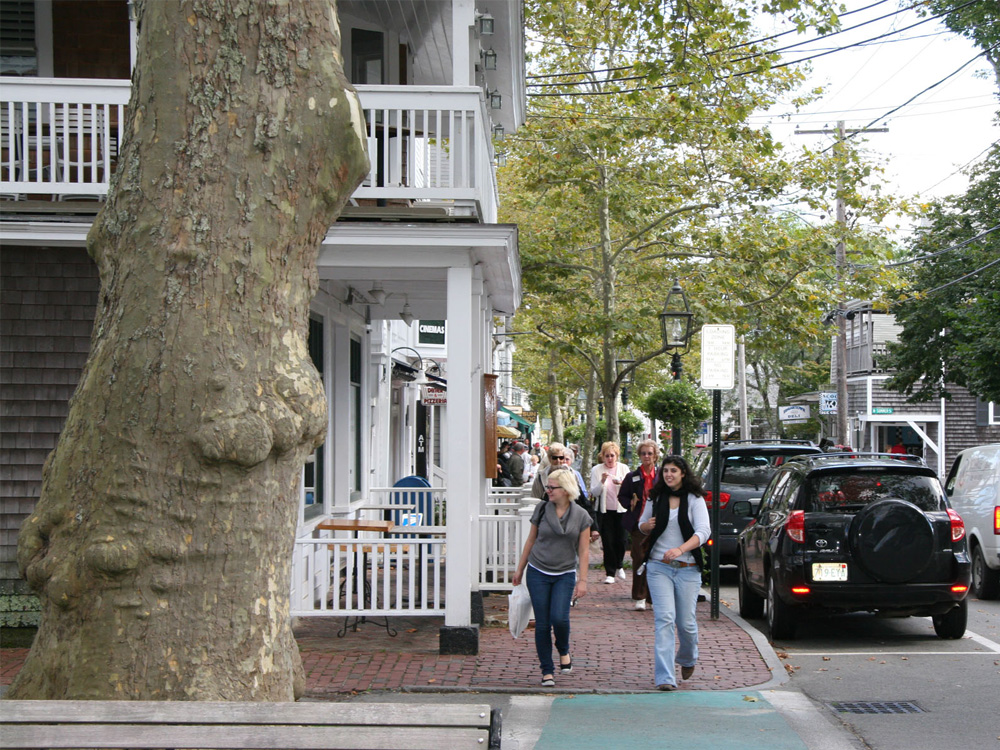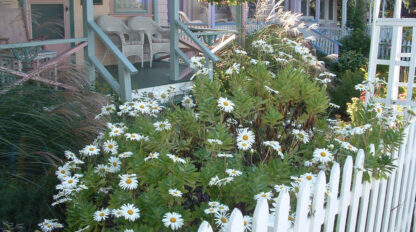6 Towns To Stay In On Martha’s Vineyard

We find that people ask “which island should I go to” and there is no easy answer because they are two completely different destinations. Yes, they are both islands, but they are unique and diverse. One of the biggest differences is the size: while Nantucket is relatively small, Martha’s Vineyard is just the opposite. With a total shoreline of 126-miles and land area of 100 square miles, Martha’s Vineyard is an island to be explored. Read on to learn more about all the towns to visit on Martha’s Vineyard!
Towns on Martha’s Vineyard
The island’s year-round population of close to 23,000 lives in six towns. From east to west, these are: Edgartown, Oak Bluffs, Vineyard Haven (Tisbury), West Tisbury, Chilmark, and Aquinnah (formerly Gay Head).
Oak Bluffs
In 1835 Oak Bluffs served as the site for annual summer camp meetings, when Methodist church groups found the groves and pastures of Martha’s Vineyard particularly well suited to all-day gospel sessions. Wesleyan Grove, as the Oak Bluffs Campground was called, rode the crest of the religious revival movement. By the mid-1850s the Sabbath meetings here were drawing congregations of 12,000 people. They came for the sunshine and sermonizing in hundreds of individual church groups. In time, the Campground residences became cottages, and the cottages multiplied—each trying to outdo each other in brightly painted fantasies of gingerbread. More than 1,000 of these wonderful, colorful “Gingerbread Cottages” still exist today, encircling the Tabernacle.
Oak Bluffs is also the home of the Flying Horses Carousel, the oldest continuously operating platform carousel in the country. Its horses were hand-carved in New York City in 1876. This historic landmark is maintained by the Martha’s Vineyard Preservation Trust. It is open daily during the summer, and on weekends in the spring and fall.
Edgartown
One of New England’s most elegant communities, Edgartown was the Island’s first colonial settlement and it has been the county seat since 1642. The stately white Greek Revival houses built by the whaling captains have been carefully maintained. Main Street is a picture-book setting with its harbor and waterfront. The tall square-rigged ships that sailed all the world’s oceans have passed from the Edgartown scene, but the heritage of those vessels and their captains has continued. For the past hundred years Edgartown has been one of the world’s great yachting centers.
To view and appreciate this town fully, you must walk its streets. On North Water Street you will find a row of captains’ houses with unequaled beauty. Many houses in Edgartown predate the whaling era. Most are private residences, but three notable ones are serving other needs. The Vincent House (built in 1672, the oldest known house on the Island) and the Thomas Cooke House are museums. The Federated Church, built in 1828 still has the old box pews, which are entered through little doors and have narrow seats around three sides. The famous Old Whaling Church with its six massive columns commands Main Street. Built in 1843 at the height of the whaling industry, the Church was given to the Martha’s Vineyard Preservation Trust in 1980. It has been transformed into a performing arts center.
Vineyard Haven (Tisbury)
Excellent shops, restaurants, and a beautiful harbor are only a few of the attractions that make Vineyard Haven special to tourists and residents alike. The town that incorporates Vineyard Haven is called Tisbury, after a parish in England near the birthplace of the Island’s first governor, Thomas Mayhew.
Owen Park, off Main Street (just beyond the shopping district), honors one of Vineyard Haven’s whaling captains. The town beach here is a fine place to watch the harbor. Ferries shuttle in and out, providing the Island’s year-round connection to the mainland. On the opposite side of Main Street from Owen Park is the Nathan Mayhew Schoolhouse. Erected in 1828, this building has served many uses. It was once a carpentry shop, a school, and later served as the Congregational Church. In front of the museum stands the tall white Liberty Pole, commemorating the daring of three young women who inserted gun powder in the base of the town’s liberty pole in 1778 and blew it up to keep it from being used as a spar by a British warship.
There are many scenic places around the town: in addition to Main Street and the harbor, the Lake Tashmoo overlook on State Road, the nearby Tisbury Water Works, West Chop Lighthouse, and the area around the drawbridge on Beach Road are favorite spots for photographers.
West Tisbury
West Tisbury with its white church, general store, post office, old mill, farms, and ponds has all the characteristics people associate with a typical New England village. It was the mill site that originally attracted settlers, because there was no stream in Edgartown strong enough to dam for a water wheel. The grist mill gave way in 1847 to the manufacture of satinet, a heavy fabric for whalemen’s jackets made from Island wool.
The Congregational Church on State Road is always open to visitors. Solid and settled as it now looks, even this structure did not escape the Islanders’ penchant for moving buildings around. The original churchyard, where the first settlers of the town are buried, is about a quarter of a mile down the road. Near the church is the West Tisbury Town Hall. Several old houses here started out as inns, back when a trip from the down-Island ports to Aquinnah or Chilmark was a long haul over sandy roads. Daniel Webster stayed at the house next to the store building. Across the little pond from the old inn is the site of a house built by Miles Standish’s son in 1668.The largest houses in town were owned by captains, and some of the finest are still occupied by their descendants. Several captains’ houses can be found on Music Street, given its name after a number of its families purchased pianos with new whaling money. Other points of interest are Cedar Tree Neck Sanctuary, and the Polly Hill Arboretum. Cedar Tree Neck offers unspoiled woods, with a freshwater pond and brooks, bounded by North Shore Beach. The Arboretum contains more than 200 species of trees, a picnic area, and Visitors’ Center.
Chilmark
Chilmark is a town of rolling hills and unmatched coastline. Not so long ago uninhabited except for an occasional farm or fishing village, it now provides the setting for many a beautiful summer home. The stone fences of the sheep farms still ribbon the hills, while the old stone animal pound stands on the South Road, a reminder of the days when a gate left open resulted in a roaming flock and a fine for its owner.
The Menemsha Crossroad joins North Road and takes one to the fishing village once known as Menemsha Creek. Here the draggers still come in with their great nets and the lobstermen land their catches. Seafood may be purchased on the spot. Lovely private vessels lie along the docks while yachtsmen take on fresh water and supplies. A safe public bathing beach is another attraction. Menemsha is also the home of a Coast Guard station. Before the days when the Coast Guard looked out for shipwrecked vessels, Vineyarders took it upon themselves to form volunteer groups that provided assistance to sailors in times of need. Open dories were launched into the stormy seas from Squibnocket Landing, the only beach on the South Shore shallow enough for a boat to be launched or landed in heavy weather. It is now a beach for year-round and summer Chilmark residents.
Aquinnah (Gay Head)
The brilliant colors of the mile-long expanse of the Aquinnah Cliffs astonished early explorers and have continued to be a source of intense interest to scientists and visitors alike. Here layers of sand, gravel, and clay of various hues tell the hundred million year old story of a land first covered with forests, then flooded and laid bare, then covered with new growth, time and again. The seas, glaciers, and land itself have contorted these once-level layers into waving bands of color that stream above the sea. Erosion continues as it has for centuries, turning the seas red and revealing fossil secrets. The Aquinnah Cliffs are a national landmark.
Because of the extremely dangerous rocky ledge offshore, the seas around Aquinnah have always been a place of great peril to the mariner. One of the first revolving lighthouses in the country was erected atop the Cliffs in 1799. It had wooden works that became swollen in damp or cold weather, when the lighthouse keeper and his wife would be obliged to stand all night and turn the light by hand. The current red-brick electrified Gay Head Light stands in its place. Many year-round residents of Aquinnah are descendants of the Wampanoag Indians who showed the colonial settlers how to kill whales, plant corn, and find clay for the early brickyards. The Aquinnah Indians were judged to be the most skillful and courageous boatsteerers of the era. Their courage was demonstrated in many instances when they took to the seas in deadly weather to aid survivors of wrecks that took place off the Aquinnah Cliffs.
What will you do with all of this information? So many possibilities! If there is one option we can steer you to, it’s how to get there!
Hop Onboard our High Speed Ferry to Oak Bluffs!
We can’t wait to take you to the Vineyard on our comfortable high speed vessels. The trip is quick, just 1 hour and you’ll be there!


